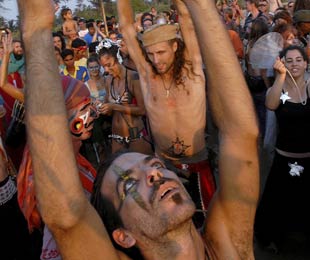
There is an interesting article over at In These Times on the disappearance of group rituals and festivals in Western and large-scale societies. Here is a brief excerpt:
I'm not so sure about the Marxist conflict approach to this, although that most surely is an aspect of it. I think there is a bigger picture to this, a way to see it as part of an integral developmental model. And Barbara Ehrenreich does look at other elements of this topic:Ours is what the French theorist Guy Debord called the “society of the spectacle,” which he described as occurring in “an epoch without festivals.” Instead of generating their own collective pleasures, people absorb, or consume, the spectacles of commercial entertainment, nationalist rituals and the consumer culture, with its endless advertisements for the pleasure of individual ownership. Debord bemoaned the passivity engendered by constant spectatorship, announcing that “the spectacle is the nightmare of imprisoned modern society which ultimately expresses nothing more than its desire to sleep.”
But there is no obvious reason why festivities and ecstatic rituals can’t survive within large-scale societies. Whole cities were swept up in the French Revolution’s Festival of Federation in 1790, with lines of dancers extending from the streets and out into the countryside. Rock events have sometimes drawn tens of thousands for days of peaceful dancing and socializing. Modern Brazil still celebrates Carnaval and Trinidad preserves its Carnival. Recent nonviolent uprisings, like Ukraine’s Orange Revolution, invariably feature rock or rap music, dancing in the streets, and “costuming” in the revolution-appropriate color. There is no apparent limit on the number of people who can celebrate together.
Nor can the growing size of human societies explain the long hostility of elites to their people’s festivities and ecstatic rituals—a hostility that goes back at least to the city-states of ancient Greece, which contained only a few tens of thousands of people each. No, the repression of festivities and ecstatic rituals over the centuries was the conscious work of men, and occasionally women, who saw in them a real and urgent threat. The aspect of “civilization” that is most hostile to festivity is not capitalism or industrialism—both of which are fairly recent innovations—but social hierarchy, which is far more ancient. When one class, or ethnic group or gender, rules over a population of subordinates, it comes to fear the empowering rituals of the subordinates as a threat to civil order.
But elite hostility to Dionysian festivities goes beyond pragmatic concerns about the possibility of uprisings or the seduction of the young. Philosophically, too, elites cringe from the spectacle of disorderly public joy. Hierarchy, by its nature, establishes boundaries between people—who can go where, who can approach whom, who is welcome, and who is not. Festivity breaks the boundaries down.From a Spiral Dynamics point of view, it would seem that the cool color Memes are the ones that might celebrate festivals in various forms -- Purple, Blue, Green, Turquoise. These Memes are more group oriented and focused on inclusion within the group (or exclusion from the group at the lower levels).While hierarchy is about exclusion, festivity generates inclusiveness. The music invites everyone to the dance; shared food briefly undermines the privilege of class. As for masks, they may serve symbolic, ritual functions, but, to the extent that they conceal identity, they also dissolve the difference between stranger and neighbor, making the neighbor temporarily strange and the stranger no more foreign than anyone else. No source of human difference or identity is immune to the carnival challenge: cross-dressers defy gender just as those who costume as priests and kings mock power and rank. At the height of the festivity, we step out of our assigned roles and statuses—of gender, ethnicity, tribe and rank—and into a brief utopia defined by egalitarianism, creativity and mutual love. This is how danced rituals and festivities served to bind prehistoric human groups, and this is what still beckons us today.
The warm color Memes (Red, Orange, Yellow), being more focused on the self, would probably not like festivals and public celebrations. These Memes might reject the group element as too threatening, both at the individual level and the societal level.
In reality, however, no person or culture is represented by a single Meme. So the author might have a point in the conflict approach -- this struggle between group dynamic and individual responsibility seems to be built in to most developed societies.
The author also mentions the Dionysian element of these festivals, echoing Nietzsche's ideas on the conflict of Dionysian and Apollonian energies in art and culture -- essentially a conflict between horizontal, sensual experience (Dionysus) and vertical, spiritual experience (Apollo). Still, I think this is contained within the SD model of conflict between group energy (Dionysus) and individual energy (Apollo).
I don't really have a point here, I'm just thinking out loud -- and it's early, so I might be rambling. Anyone have any thoughts on this article? I'd like to hear what others think.
No comments:
Post a Comment